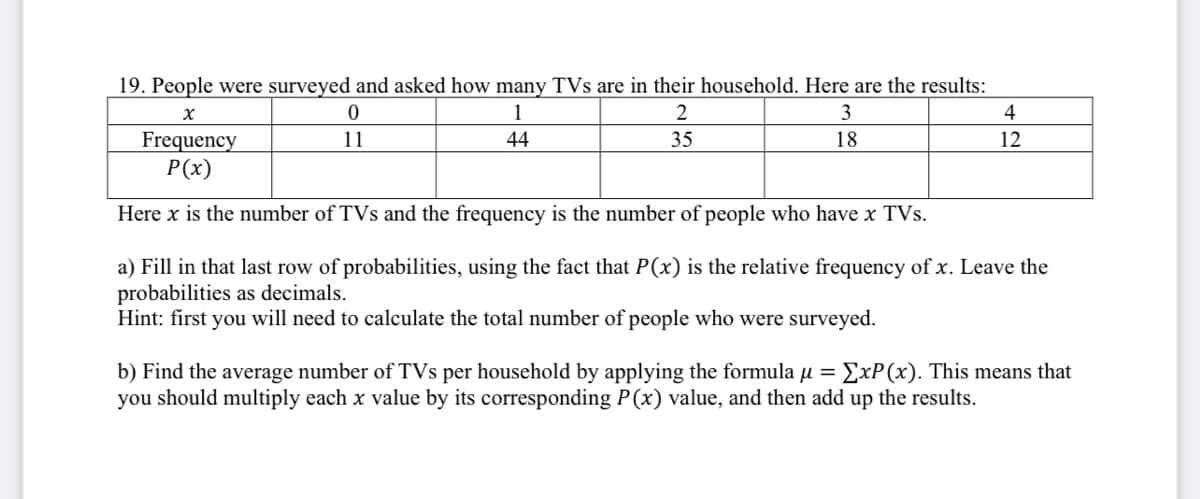19. People were surveyed and asked how many TVs are in their household. Here are the results: 1 2 3 4 Frequency P(x) 11 44 35 18 12 Here x is the number of TVs and the frequency is the number of people who have x TVs. a) Fill in that last row of probabilities, using the fact that P(x) is the relative frequency of x. Leave the probabilities as decimals. Hint: first you will need to calculate the total number of people who were surveyed. b) Find the average number of TVs per household by applying the formula µ = ExP(x). This means that you should multiply each x value by its corresponding P(x) value, and then add up the results.
19. People were surveyed and asked how many TVs are in their household. Here are the results: 1 2 3 4 Frequency P(x) 11 44 35 18 12 Here x is the number of TVs and the frequency is the number of people who have x TVs. a) Fill in that last row of probabilities, using the fact that P(x) is the relative frequency of x. Leave the probabilities as decimals. Hint: first you will need to calculate the total number of people who were surveyed. b) Find the average number of TVs per household by applying the formula µ = ExP(x). This means that you should multiply each x value by its corresponding P(x) value, and then add up the results.
College Algebra
7th Edition
ISBN:9781305115545
Author:James Stewart, Lothar Redlin, Saleem Watson
Publisher:James Stewart, Lothar Redlin, Saleem Watson
Chapter9: Counting And Probability
Section9.3: Binomial Probability
Problem 2E: If a binomial experiment has probability p success, then the probability of failure is...
Related questions
Question
please 19a,19b thank you

Transcribed Image Text:19. People were surveyed and asked how many TVs are in their household. Here are the results:
1
3
4
44
35
12
Frequency
P(x)
11
18
Here x is the number of TVs and the frequency is the number of people who have x TVs.
a) Fill in that last row of probabilities, using the fact that P(x) is the relative frequency of x. Leave the
probabilities as decimals.
Hint: first you will need to calculate the total number of people who were surveyed.
ExP(x). This means that
b) Find the average number of TVs per household by applying the formula u =
you should multiply each x value by its corresponding P(x) value, and then add up the results.
Expert Solution
This question has been solved!
Explore an expertly crafted, step-by-step solution for a thorough understanding of key concepts.
Step by step
Solved in 2 steps with 2 images

Recommended textbooks for you

College Algebra
Algebra
ISBN:
9781305115545
Author:
James Stewart, Lothar Redlin, Saleem Watson
Publisher:
Cengage Learning


College Algebra
Algebra
ISBN:
9781305115545
Author:
James Stewart, Lothar Redlin, Saleem Watson
Publisher:
Cengage Learning
